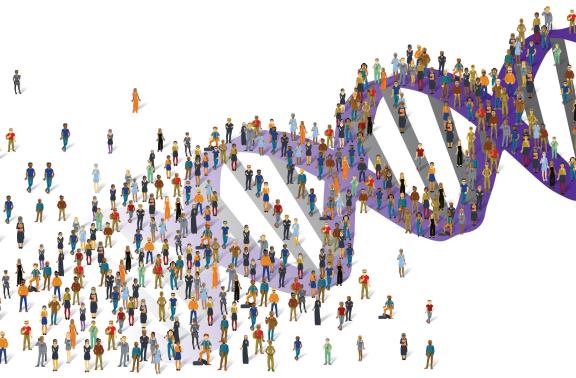
How Does Genetic Ancestry Testing Affect Perceptions of Race? Wendy Roth and Ariela Schachter Share Insights and Research Tools from New Study
Genetic Ancestry Testing (GAT) has rapidly grown in popularity. In 2022, an estimated one-in-five U.S. adults, approximately 50 million Americans, reported using a mail-in DNA testing service. As more people participate in GAT, ELSI scholars have emphasized the importance of examining how the public’s understanding of genomics interacts with evolving concepts of race, ethnicity, and ancestry.
CERA staff spoke with Wendy D. Roth, PhD and Ariela Schachter, PhD, the co-principal investigators of the NIH R21 grant How Does Genetic Ancestry Testing Affect Perceptions of Race? Their project investigates the relative influence of genetic, phenotypic, and social attributes in shaping how individuals perceive other people’s race. Drs. Roth and Schachter generously shared two research instruments that were developed for the study: a conjoint survey instrument and the Black-White Race Morphs Research Tool, both of which are now accessible in the ELSIhub Research Tools database.
Dr. Roth is a Professor of Sociology at the University of Pennsylvania, and Dr. Schachter is an Associate Professor of Sociology at Washington University in St. Louis.
CERA: Your study, How Does Genetic Ancestry Testing Affect Perceptions of Race?, aims to investigate the relative influence of genetic, phenotypic, and social attributes in shaping how individuals perceive race. Could you please say a little about why is it important to enhance our understanding about how racial classification works? Why is important to understand the impacts of genetic ancestry testing on racial classification specifically?
Drs. Roth and Schachter: While a substantial amount of survey data relies on participants self-identifying their race, this may not aways align with what others assume their race to be. Moreover, other people’s perceptions may play a larger role in how someone is treated in society. Experiences with discrimination, for instance, often have more to do with classification by others than with self-identification. That makes it really important to understand how other people make racial classifications and what they base them on.
Since direct-to-consumer genetic ancestry testing became available, many scholars and others have expressed concerns that the test results will reify race, leading people to believe that race is genetically determined and promoting belief in essential racial differences. “Geneticized” conceptions of race have been associated with prejudice and racism and have led to eugenics and genocide, so they are a great cause for concern. Several studies, including some of our own, have suggested that many people who take genetic ancestry tests adopt more “geneticized” conceptions of race and change their racial identity based on their test results. In this study, we want to understand whether genetic ancestry information, or the racial self-identities that people fashion based on them, also influence how others perceive their race. As more people take direct-to-consumer genetic ancestry tests—and current estimates show that 21% of all U.S. adults have taken them—the increased genomic knowledge people have could be shifting norms of racial classifications. This could have significant social implications, ranging from changes in patient-provider interactions and assessment in healthcare settings to demographic shifts and identity-based political mobilization.
CERA: You have described this study as a “conjoint survey experiment”. For others who might be interested in using this method, could you please tell us more about it and why you selected it for this study?
Drs. Roth and Schachter: A conjoint survey experiment allows researchers to determine the causal impact of multiple different influences. We’re interested in knowing not just how genetic ancestry information influences how observers perceive a person’s race, but also the impact it has relative to other factors, such as: their appearance, how they self-identified before testing, how their racial identity changed after testing, and the social context. A conjoint survey experiment allows us to show profiles of individuals to respondents and randomize the information about each of those factors. Then, the analysis can isolate the causal impact of each factor, both individually and in interaction with others, to determine their impact on how respondents classify the profiled individual’s race.
CERA: You have shared two research tools with the ELSI community, the How Does Genetic Ancestry Testing Affect Perceptions of Race? Conjoint Survey Instrument and the Black-White Race Morphs Research Tool. Could you please explain what motivated you to create these tools? Any advice for other researchers who might be interested in using or adapting them for new purposes?
Drs. Roth and Schachter: We created the Black-White Race Morphs Research Tool to have a set of photos we could use in the experimental profiles. One of the factors we wanted to vary is phenotype, so we could see how that influences racial classification relative to other factors like genetic ancestry information. We used a photo morphing technique to blend together facial images of individuals consistently perceived as White and individuals consistently perceived as Black, in varying proportions. This gave us a set of photos that range from looking “more Black,” to more “racially ambiguous,” to “more White.” It can be very helpful for experimental research to have a set of pre-tested photos that show some systematic variation in appearance, and we hope it can be used by other researchers too.
The How Does Genetic Ancestry Testing Affect Perceptions of Race? Conjoint Survey Instrument shows our survey questions and how we set up the conjoint experimental profiles. It can allow others to reproduce these results or do further research with other specifications. We hope it might also be of use to other researchers who are interested in doing their own conjoint experiments on other topics, just to see how the survey questions are set up.
CERA: What is the value of a sociological perspective to the study of the ethical, legal, and social implications of direct-to-consumer genetic ancestry tests?
Drs. Roth and Schachter: The sociological perspective emphasizes the ‘social’ part of the ethical, legal, and social implications of genomics. Genomic advances and technologies have made new information widely available to the public and that may influence or reshape the social systems and norms around us. This is particularly true with direct-to-consumer genetic ancestry tests because they’re so widely available and may well be the primary way that the general public interacts with the genomic revolution. Understanding how this technology and this widespread information is changing social norms for things like how we think about race could not be more important.
The ELSIhub Research Tools Database hosts over 200 research instruments, including surveys, interview guides, consent templates, and more. Read our FAQs to learn more or email us at [email protected] to share your published or unpublished research tools with the ELSI research community.


